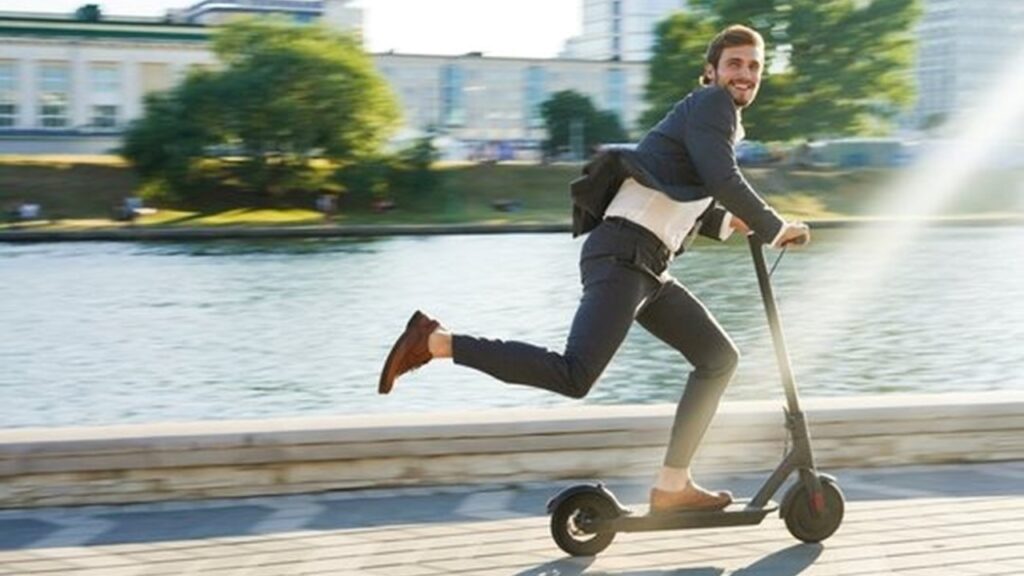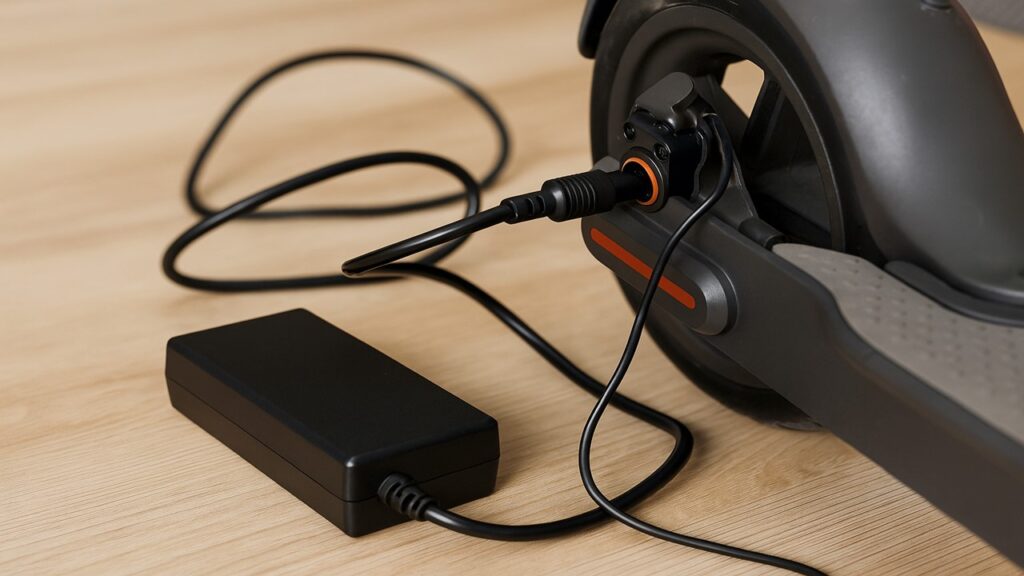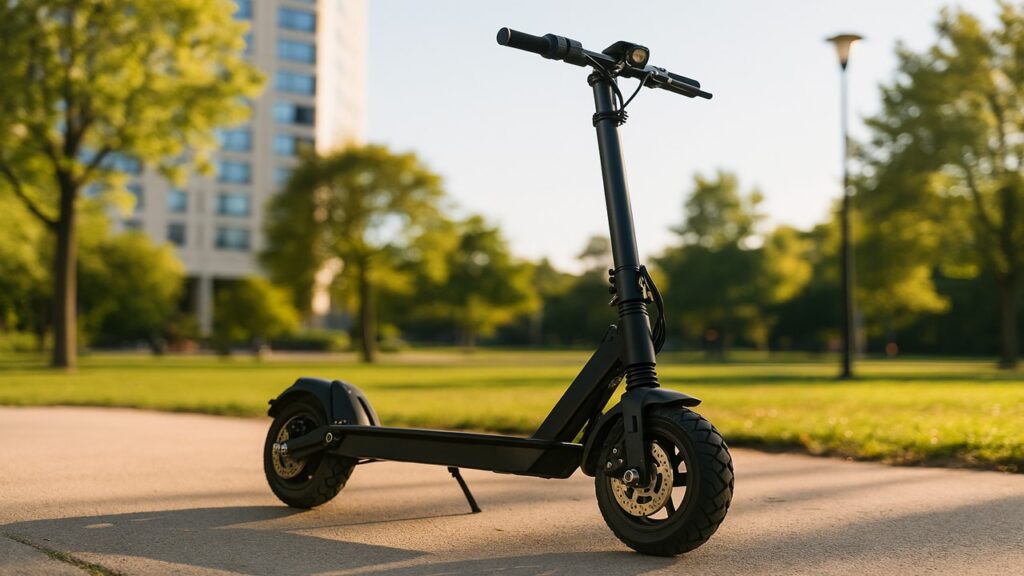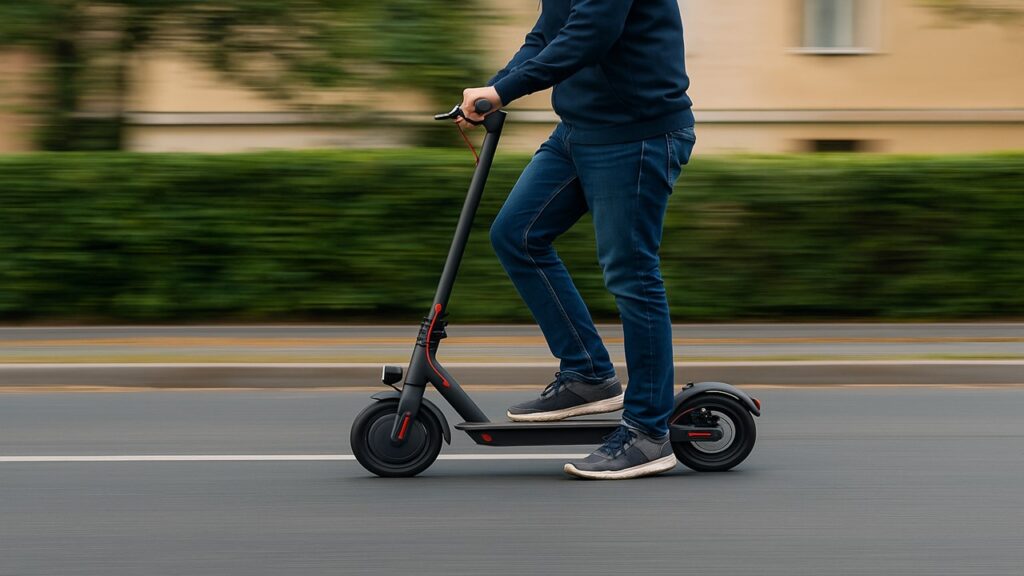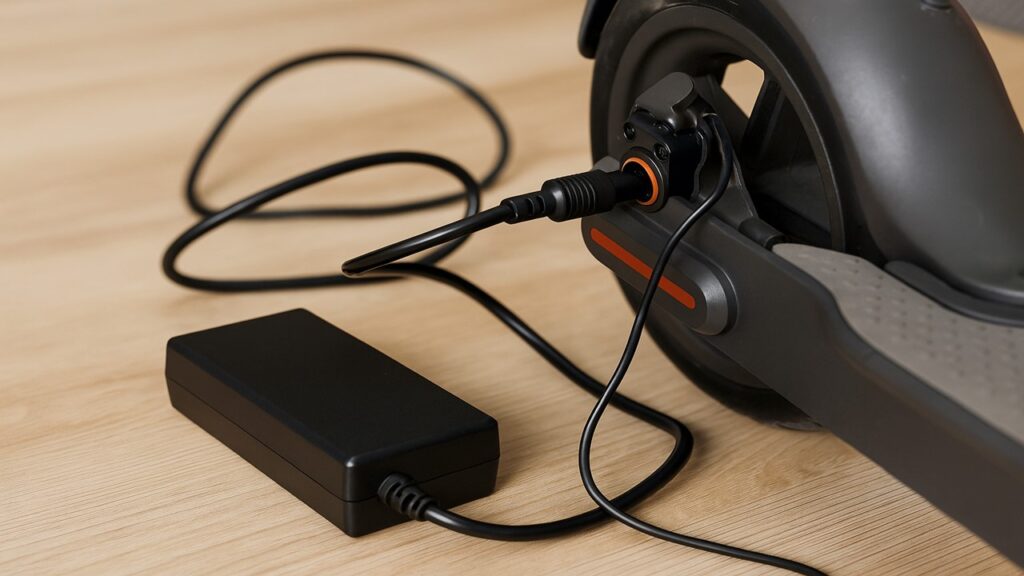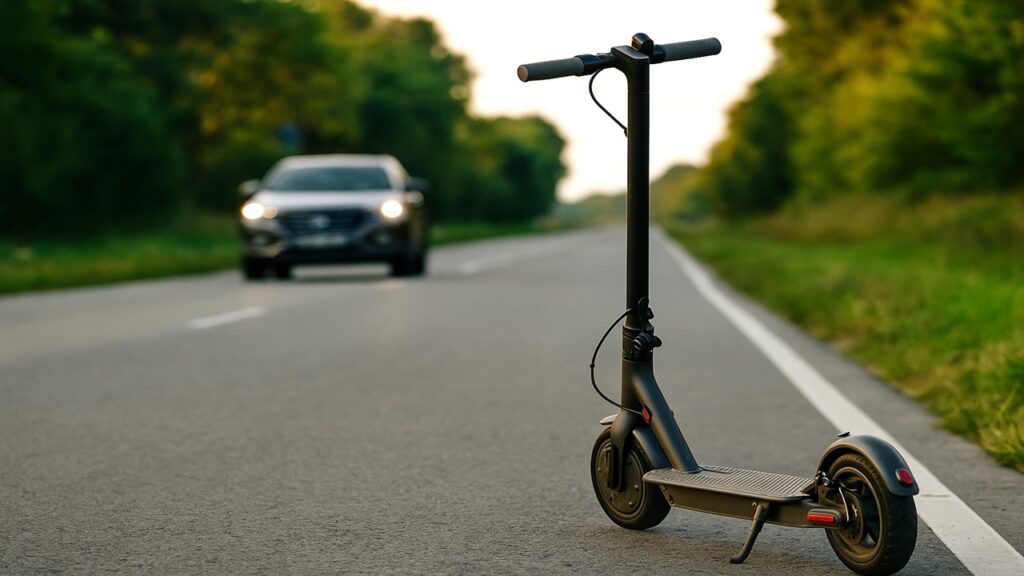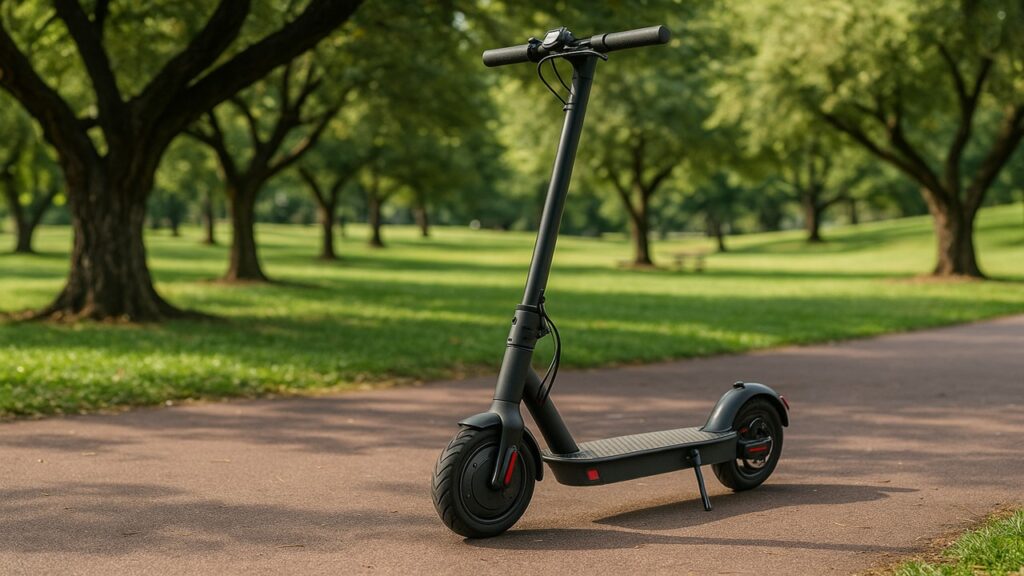
If you lose or break your electric scooter charger, you can still power up using safe alternatives like a car inverter with your OEM charger, USB-C Power Delivery (if supported), or a verified compatible charger. These methods work as temporary solutions, but the safest long-term option is always replacing your original charger.
Key Summary
- Charging without the original charger is possible, but every method carries risks.
- The safest temporary solution is using your OEM charger with a car inverter or portable power station.
- USB-C Power Delivery works only on newer scooters designed for it and charges much slower.
- Replacement or universal chargers are safe only if voltage, amperage, connector, and polarity all match exactly.
- Direct-to-battery or bench power supply charging is expert-only and bypasses built-in safety protections.
- Always monitor charging, avoid overheating, and never leave the scooter unattended.
- For long-term safety, invest in an OEM charger and follow good battery care habits.
Why You Might Need to Charge Electric Scooter Without a Charger
Sometimes riders find themselves without the original charger of their electric scooter, and the reasons are more common than you might think. Knowing these scenarios helps you prepare for safe alternatives when needed.
- Lost or damaged charger: Chargers are bulky, easy to misplace, and can fail over time.
- Traveling light: Many riders leave the charger at home to reduce what they carry.
- Second-hand purchase: Used scooters often come without a charger included.
- Older models: Replacement chargers may no longer be available from the manufacturer.
- Unexpected emergencies: Running out of battery far from home can leave you stranded without access to your charger.
Understanding these situations highlights why learning safe emergency charging methods is valuable.
Can You Really Charge an Electric Scooter Without the Original Charger?
Yes, it is technically possible to charge an electric scooter without its original charger, but it comes with important caveats. The scooter battery relies on very specific voltage, amperage, and polarity to charge safely. Deviating from those values can damage the battery or its Battery Management System (BMS).
OEM chargers are designed to match the exact needs of your scooter. When you replace that with a universal charger, USB-C PD adapter, or direct power source, you take on risk. If voltage is too high, you can permanently harm the battery. If amperage is mismatched, charging will either be too slow or cause overheating. Polarity errors can instantly short-circuit the pack.
In short, charging without the original charger is possible, but it should be considered a last resort and approached with careful planning, proper tools, and constant monitoring.
Safety Precautions Before Trying Any Alternative
Charging an electric scooter with anything other than the original charger increases risk. Before you attempt any method, prioritize safety and preparation.
Key precautions:
- Turn the scooter off completely. Prevent accidental current draw during charging.
- Work in a ventilated, fire-safe space. Place the scooter on a non-flammable surface away from flammable objects.
- Wear basic safety gear. Gloves and safety glasses protect against sparks or short circuits.
- Have a fire extinguisher nearby. Lithium-ion batteries can ignite if things go wrong.
- Double-check voltage, current, and polarity. Use a multimeter if needed to confirm specs before plugging in.
- Monitor the process. Never leave your scooter charging unattended with non-OEM methods.
These steps reduce—but do not eliminate—the risks. Treat all emergency charging as temporary, and replace your charger as soon as possible.
Methods to Charge an Electric Scooter Without Charger
There are several ways to power your electric scooter when the original charger is missing. Each method works differently, and not all are equally safe.
Main alternatives include:
- Using your OEM charger with a car inverter or portable power station
- Charging through USB-C Power Delivery, if your scooter supports it
- Finding a compatible replacement or universal charger with exact specs
- Tapping into a solar setup or power bank for small scooters or emergencies
- Employing a bench DC power supply if you have technical expertise
Let’s look at these options in more detail.
OEM Charger with Car Inverter or Portable Power Station
This is the safest emergency method. Plug your factory charger into a car inverter or the AC outlet of a power station. It works because the OEM charger regulates voltage, current, and polarity exactly for your scooter. The only downside is efficiency loss and needing access to a car or power station.
USB-C Power Delivery (If Supported)
Some newer scooters have USB-C PD support. With a 45W–100W+ PD adapter and certified cable, you can trickle-charge the battery. This is much slower than the OEM charger but useful for topping up when stranded. Always check your scooter manual to confirm PD support before attempting.
Compatible Replacement or Universal Charger
If you can find a charger with identical voltage, amperage, connector type, and polarity, this is a safe substitute. Use a multimeter to confirm specs before connecting. A mismatch, even by a few volts, can damage the battery.
Solar Setup or Power Bank
A solar panel with a charge controller can charge scooters, but it is slow and depends heavily on weather. High-capacity DC power banks may work for kids’ scooters or smaller packs. These methods are best for light emergency use.
Bench DC Power Supply (Expert-Only)
An adjustable power supply can be set to match exact voltage and current. It bypasses safety features, so it should only be used by someone with electrical knowledge. Incorrect settings or polarity can permanently damage the battery.
Direct-to-Battery Charging (Last Resort)
In some cases, the charging port of the electric scooter may be damaged, or no compatible charger is available. You can access the scooter’s battery directly by opening the deck and connecting wires from a DC power supply straight to the terminals. Always connect positive to positive and negative to negative.
This method is extremely risky because it bypasses the Battery Management System. Without built-in protections, the battery is more vulnerable to overheating, swelling, or short circuits. It should only be done as a last resort by someone who understands electrical safety.
Common Mistakes to Avoid
Charging an electric scooter without its original charger is possible, but it comes with serious risks if done carelessly. Many riders damage their batteries or create fire hazards by skipping simple checks. Knowing the most common mistakes can help you avoid costly or dangerous outcomes.
Mistakes to watch out for:
- Using a laptop or phone charger on a scooter battery
- Guessing polarity instead of confirming with a multimeter
- Overcharging past the rated battery voltage
- Charging unattended in unsafe environments
- Riding immediately after charging while the pack is still hot
Avoiding these errors reduces the risk of damaging your scooter or starting a fire. Always prioritize safety and use emergency methods only until a proper charger is available.
Maintaining Battery Health to Prevent Charging Issues
A healthy battery of an electric scooter is easier to charge and less likely to fail when you need it most. Taking care of your scooter’s battery ensures longer lifespan and reduces the chances you will ever need risky alternatives.
Good charging practice means avoiding deep discharges. A lithium-ion scooter battery performs best when kept between 20 percent and 80 percent of charge. Fully draining the pack on a regular basis puts unnecessary strain on the cells and shortens usable life.
Storage conditions matter too. If you won’t be riding for weeks, keep the battery at around 40 to 60 percent charge in a cool, dry place. Overcharging or leaving it plugged in for days can cause overheating and gradual degradation.
Checking the charger, cables, and ports regularly also helps you spot problems early before they turn into charging failures.
Understanding Battery and Charger Compatibility
Safe charging of an electric scooter depends on matching your scooter battery with the correct power supply. The key specifications to align are:
- Voltage must match the scooter’s rated full charge voltage.
- Amperage (current) should be equal to or slightly higher than the original charger.
- Connector type must fit securely without modification.
- Polarity requires connecting positive to positive and negative to negative.
If any of these specifications are mismatched, charging becomes unsafe. Let’s look at them in more detail.
Voltage Mapping (Nominal vs. Charger Voltage)
Scooter batteries are labeled with a nominal voltage, which is the average during discharge, and a full charge voltage, which is the level the charger delivers. Correct pairings include:
- A 24V battery pairs with a 29.4V charger
- A 36V battery pairs with a 42V charger
- A 48V battery pairs with a 54.6V charger
- A 52V battery pairs with a 58.8V charger
- A 60V battery pairs with a 67.2V charger
- A 72V battery pairs with an 84V charger
Using the wrong voltage either leaves the battery undercharged (too low) or risks permanent damage (too high).
Current (Amps) Guidelines
A scooter battery only draws the current it requires, but the charger must be capable of providing at least as much as the OEM model. Lower amperage means slower charging. Higher amperage can cause overheating if it exceeds safe limits.
Connector and Polarity
Common connector types include barrel plugs and XLR three-pin connectors. Always verify polarity with a multimeter if you are unsure. Reversed polarity is one of the most common causes of battery failure.
Charge-Time Comparison by Method
Charging speed of an electric scooter depends on the wattage of the charging method, the efficiency of the setup, and your scooter’s battery capacity. Higher wattage usually means faster charging, but only when voltage and current are properly matched.
| Method | Typical Power (W) | Efficiency | 360Wh Battery Example | Risk Level | Notes |
| OEM Charger (AC) | 120W | 85–90% | ~3.5 hrs | Very Low | Safest option |
| Car Inverter + OEM Charger | 120W | 80–85% | ~4 hrs | Low | Requires running car |
| USB-C PD 65W | ~55W | ~80% | ~7–8 hrs | Medium | Only if scooter supports PD |
| Portable Power Bank (DC Out) | 40–60W | ~75% | 6–9 hrs | Medium | Suitable for small scooters |
| Solar Panel + Controller | 20–50W | ~60% | 8–12 hrs+ | Medium | Weather dependent |
| Bench Power Supply (DIY) | Variable | ~80% | Varies | High | Expert-only, bypasses BMS |
This comparison highlights why an OEM charger is always the most efficient and reliable choice. Other methods are useful only in temporary or emergency situations.
Conclusion
Charging an electric scooter without its original charger is possible, but every alternative method comes with trade-offs. The safest path is always using an OEM charger or a verified compatible replacement.
Emergency solutions like car inverters, USB-C PD charging, or portable power stations can work, but they require strict attention to voltage, current, and polarity.
If you must charge without the original charger, treat it as a short-term fix. Monitor the process closely, avoid common mistakes, and never leave the battery unattended. In the long run, investing in a proper charger protects your battery, your scooter, and your safety.
Related FAQs
Can I use a laptop or phone charger for my scooter?
No, laptop and phone chargers do not match the voltage or current required for scooter batteries. Using them can damage the battery or cause overheating.
Is it safe to use a universal charger?
It can be safe only if the voltage, amperage, connector, and polarity exactly match your scooter’s specifications. Even a small mismatch creates risks of battery failure or fire.
How long does USB-C charging take?
USB-C Power Delivery works only on scooters designed for it. With a 65W adapter, expect 7–8 hours for a mid-size 360Wh battery, which is slower than an OEM charger.
Will using a non-OEM charger void my warranty?
Yes, most manufacturers clearly state that using non-approved chargers voids the warranty. This is why OEM replacements are always the safest investment.
What is the safest emergency option?
The safest emergency method is using your OEM charger with a car inverter or portable power station. This setup maintains proper voltage, current, and polarity control.

At our core, we’re a group of passionate scooter enthusiasts. We dive deep into the world of tech, especially when it’s about your everyday usable scooters to make riding convinient. We try to provide as much value to the readers with our information and how to blog articles as possible. We take great satisfaction in offering unbiased evaluations, ensuring that you can make informed decisions when investing in your desired scooters and riding equipments.




